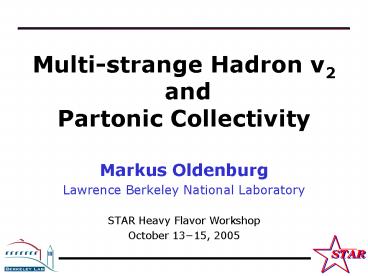Multistrange Hadron v2 and Partonic Collectivity PowerPoint PPT Presentation
1 / 14
Title: Multistrange Hadron v2 and Partonic Collectivity
1
Multi-strange Hadron v2 and Partonic
Collectivity
- Markus Oldenburg
- Lawrence Berkeley National Laboratory
- STAR Heavy Flavor Workshop
- October 13-15, 2005
2
Overview
- Motivation on why to measure
- v2 of multi-strange hadrons
- Analysis details and technique
- Data and results
- Discussion
- Conclusion
- Outlook
- from multi-strange to heavy flavor
3
Timeline of a heavy-ion collision
by S. Bass
4
Flow of strange hadrons
- freeze-out of multi-strange hadrons
- - at higher
- temperature Tfo
- - with lower
- collective
- velocity ??T?
- small cross section of strange hadrons with
non-strange hadrons - sensitivity to the early, partonic stage
STAR
Nucl. Phys. A715, 458c (2003) Phys. Rev. Lett.
92, 112301 (2004) Phys. Rev. Lett. 92, 182301
(2004)
5
Importance of ? v2
STAR Phys. Rev. C65, 041901(R) (02) Phys.
Lett. B612, 181 (2005)
Kaon coalescence effectively ruled out as a
dominant channel for ? production at these
energies.
- ? is a true signal from the early stage of the
collision! - anisotropic flow measurement of ? will conclude
- type of the system at an early stage
- partonic vs. hadronic
- origin of observed scaling at intermediate pT
- mass vs. particle type
6
Elliptic flow v2
- non-central collisions azimuthal anisotropy in
coordinate-space - interactions ? asymmetry in momentum-space
- sensitive to early time in the systems evolution
- Measurement Fourier expansion of the azimuthal
pT distribution
7
Dataset
- system AuAu collisions
- energy ?sNN 200 GeV
- event sample 11 M events
- centrality 080
- event plane
- resolution 75
- correction
8
Particle identification and mass spectra
- ?
- identified via decay topology
- ? K K-
- background estimation by event mixing
- gt 10,000,000 particles identified
O- and (anti-O) identified via decay
topology ? ? ? K and ? ? p ? background
estimated by rotating the ? by 180 in the
transverse plane gt 13,000 particles identified
?- and (anti- ?) identified via decay
topology ? ? ? ? and ? ? p ? background
estimated by rotating the ? by 180 in the
transverse plane gt 450,000 particles identified
? results by Sarah Blyth
9
New analysis technique
- analysis method v2 vs. minv
- motivated by
- Borghini et al. nucl-th/0407041
- advantages over standard method
- only one fit per pT bin
- smaller systematic uncertainties
- new method used for K0S, ?, ?, ?, and ? analysis
- standard method and v2 vs. minv method give
consistent results
SIG BG
BG
BG (SIGBG)
SIG (SIGBG)
v2TOT(minv)
10
v2 of multi-strange hadrons
_
- common fit to K and ?
- n number of constituent quarks
- X. Dong et al.,
- Phys. Lett. B597 (2004)
v2
?? OO ?
_
baryons
mesons
_
200 GeV AuAu
_
? results by Sarah Blyth
11
Discussion of strange hadron v2 results
K0S and ? results by Yan Lu
STAR preliminary
? results by Sarah Blyth
Hydro P. Huovinen, priv. comm. (2004)
- ? flows as strongly as other mesons.
- Collective flow is generated during the partonic
stage already.
- The strange baryons ? and O show strong elliptic
flow. - The ? v2 clearly follows the baryon v2(pT).
12
Conclusions from the measurements
- v2 of multi-strange hadrons
- ?, ?, and ? show strong elliptic flow.
- Their behavior is similar to the other mesons and
baryons. - They flow as strongly as the other particles.
- NCQ scaling of v2
- observed scaling is a meson?baryon, not a mass
effect!
- Collectivity develops early among partons!
- Partonic Collectivity at RHIC
Thermalization?
13
Timeline of a heavy-ion collision
by S. Bass
14
Heavy-Flavor Quarks
B. Mueller, nucl-th/0404015.
- Even in a QGP with chiral restoration, the c, b
(and t) quarks stay heavy.
- If charm quarks show collective behavior ( flow)
the must have suffered frequent interactions with
the light quarks u, d, s. - The light quarks u, d, s must be thermalized.

